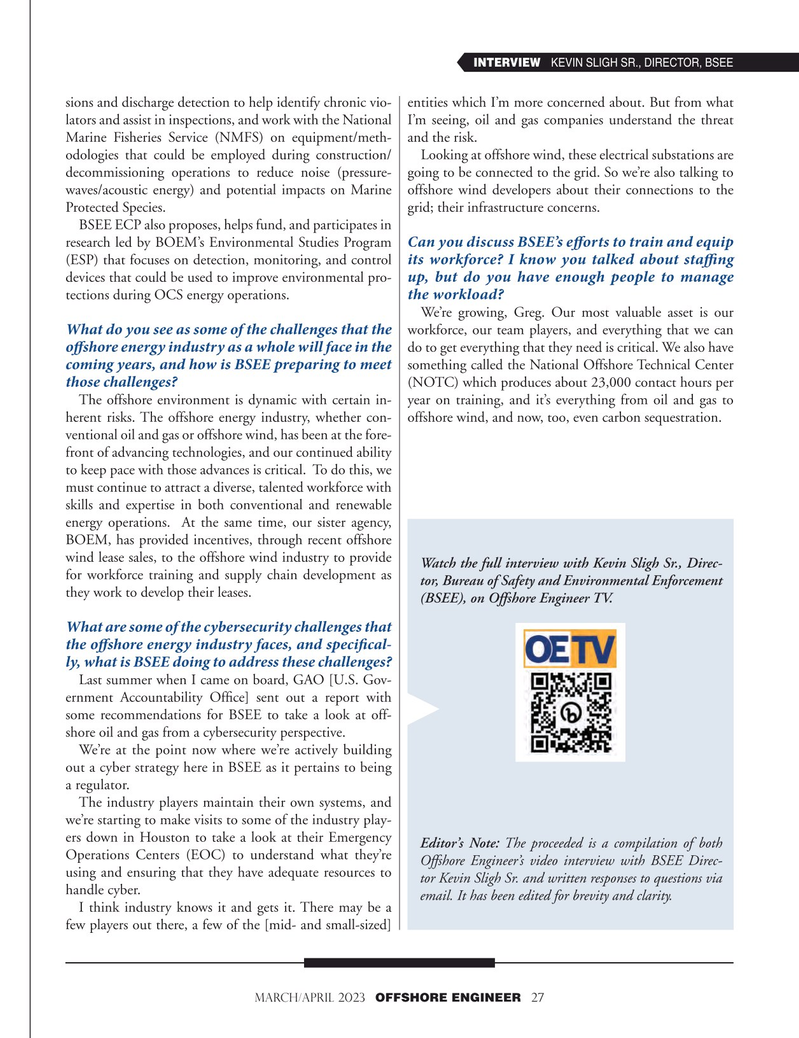
Page 27: of Offshore Engineer Magazine (Mar/Apr 2023)
Read this page in Pdf, Flash or Html5 edition of Mar/Apr 2023 Offshore Engineer Magazine
INTERVIEW KEVIN SLIGH SR., DIRECTOR, BSEE sions and discharge detection to help identify chronic vio- entities which I’m more concerned about. But from what lators and assist in inspections, and work with the National I’m seeing, oil and gas companies understand the threat
Marine Fisheries Service (NMFS) on equipment/meth- and the risk. odologies that could be employed during construction/ Looking at offshore wind, these electrical substations are decommissioning operations to reduce noise (pressure- going to be connected to the grid. So we’re also talking to waves/acoustic energy) and potential impacts on Marine offshore wind developers about their connections to the
Protected Species. grid; their infrastructure concerns.
BSEE ECP also proposes, helps fund, and participates in research led by BOEM’s Environmental Studies Program Can you discuss BSEE’s eforts to train and equip its workforce? I know you talked about stafng (ESP) that focuses on detection, monitoring, and control up, but do you have enough people to manage devices that could be used to improve environmental pro- the workload?
tections during OCS energy operations.
We’re growing, Greg. Our most valuable asset is our
What do you see as some of the challenges that the workforce, our team players, and everything that we can ofshore energy industry as a whole will face in the do to get everything that they need is critical. We also have coming years, and how is BSEE preparing to meet something called the National Offshore Technical Center those challenges?
(NOTC) which produces about 23,000 contact hours per
The offshore environment is dynamic with certain in- year on training, and it’s everything from oil and gas to herent risks. The offshore energy industry, whether con- offshore wind, and now, too, even carbon sequestration. ventional oil and gas or offshore wind, has been at the fore- front of advancing technologies, and our continued ability to keep pace with those advances is critical. To do this, we must continue to attract a diverse, talented workforce with skills and expertise in both conventional and renewable energy operations. At the same time, our sister agency,
BOEM, has provided incentives, through recent offshore wind lease sales, to the offshore wind industry to provide
Watch the full interview with Kevin Sligh Sr., Direc- for workforce training and supply chain development as tor, Bureau of Safety and Environmental Enforcement they work to develop their leases. (BSEE), on Offshore Engineer TV.
What are some of the cybersecurity challenges that the ofshore energy industry faces, and specifcal- ly, what is BSEE doing to address these challenges?
Last summer when I came on board, GAO [U.S. Gov- ernment Accountability Offce] sent out a report with some recommendations for BSEE to take a look at off- shore oil and gas from a cybersecurity perspective.
We’re at the point now where we’re actively building out a cyber strategy here in BSEE as it pertains to being a regulator.
The industry players maintain their own systems, and we’re starting to make visits to some of the industry play- ers down in Houston to take a look at their Emergency
Editor’s Note: The proceeded is a compilation of both
Operations Centers (EOC) to understand what they’re
Offshore Engineer’s video interview with BSEE Direc- using and ensuring that they have adequate resources to tor Kevin Sligh Sr. and written responses to questions via handle cyber. email. It has been edited for brevity and clarity.
I think industry knows it and gets it. There may be a few players out there, a few of the [mid- and small-sized]
MARCH/APRIL 2023 OFFSHORE ENGINEER 27

 26
26

 28
28